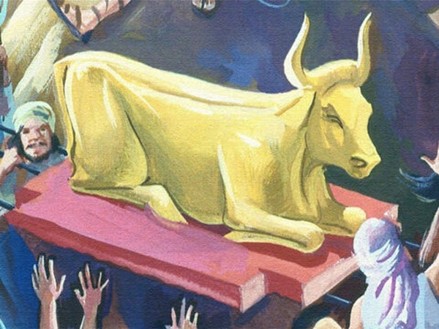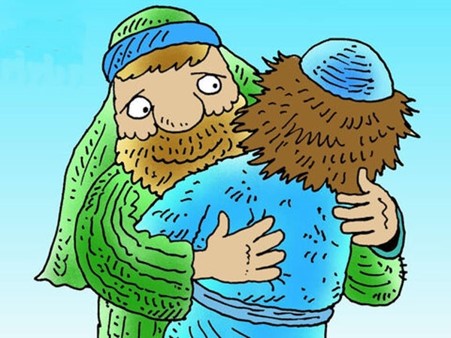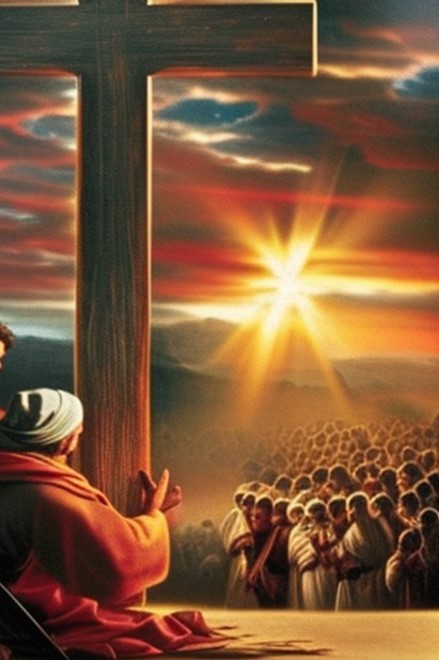Good morning!
Greetings in the name of the Father, the Son, and the Holy Spirit.
For all have sinned and fall short of the glory of God. – Romans 3:23

In our journey of faith, we continuously encounter powerful symbols that resonate deeply, shedding light on divine truths that sometimes elude verbal expression. Such a symbolic instance unfolds in Exodus 32:15-19. Here, Moses descends from Mount Sinai, the divine commandments in hand, only to behold the Israelites lost in idolatrous celebration. In a moment charged with profound sorrow and disappointment, he shatters the tablets. This act transcends a mere display of anger. It embodies the shattering of a sacred covenant — an agreement that the Israelites had broken even before it was etched in stone.
This vivid imagery of the broken tablets is strikingly reminiscent of our human frailty, highlighting how we, too, frequently stray from our commitments to God. The Apostle Paul reminds us in Romans 3:23, “For all have sinned and fall short of the glory of God.” Yet, even in this narrative of brokenness, there is an undercurrent of hope. For as we reflect upon these shattered tablets, we are also ushered into the realm of the New Testament, where hope is reborn, covenants are renewed, and the ultimate atonement is realized through the sacrifice of Jesus Christ on the cross.

The Weight of the Tablets
Exodus 32:15 paints a vivid picture: Moses, having spent intimate moments with God on Mount Sinai, descends with two stone tablets. These were no ordinary stones. They bore the divine inscription of God’s commandments, a tangible testament of a covenant between the Creator and His chosen people. Each etching served not just as a rule but as a reflection of God’s heart and the sanctity of the relationship He sought with the Israelites.
The profound significance of these tablets cannot be understated. Carved by God’s own finger, they represented the Divine’s earnest aspirations for humanity. They delineated not only laws but a way of life, marking out paths of righteousness, justice, and love. The commandments were a map to a blessed life, promising prosperity and peace for those who walked in their light.
Yet, the jubilant atmosphere of receiving God’s literal handwriting was overshadowed by a sight that tore at Moses’ heart. The camp below was in disarray. The Israelites, in their impatience, had crafted a golden calf, dancing and reveling around it. Their actions directly contravened the explicit commands: “You shall have no other gods before me” (Exodus 20:3) and “You shall not make for yourself an idol” (Exodus 20:4). The sound of their celebrations was jarring against the backdrop of God’s holy standards, making the tablets in Moses’ hands a weight too heavy to bear.
The New Testament too, paints the portrait of this perpetual tension between God’s sanctity and human weakness. Paul’s lament in Romans 7:15, “I do not understand what I do. For what I want to do I do not do, but what I hate I do,” is an articulation of the struggle of the human soul. Drawn towards God’s light yet entangled in earthly desires, humanity consistently finds itself at a crossroads.
In shattering the tablets, Moses wasn’t just expressing his own frustration or disappointment. He symbolized humanity’s consistent propensity to break God’s heart and commandments. This moment of despair, however, is not where the story ends. It is but a precursor to the message of redemption and hope. The broken tablets echo humanity’s broken relationship with God, highlighting an undeniable chasm. But isn’t it the story of the entire Bible? The narrative of our repeated failures and God’s relentless pursuit to mend, restore, and redeem?
The Gospel beautifully encapsulates this theme of restoration. While the law revealed our fractures, Christ offered the cure. Jesus proclaimed in Matthew 5:17, “Do not think that I have come to abolish the Law or the Prophets; I have not come to abolish them but to fulfill them.” In Him, the broken covenant finds its repairman. Through His sacrifice, the breach between humanity and God is bridged. Jesus, recognizing our inability to carry the weight of the law, took it upon Himself, offering grace where we faltered.
As we reflect on the shattered tablets, we are reminded of our own brokenness, our sins, and our transgressions. Yet, intertwined with this memory is the hope of salvation, the promise of a New Covenant in Christ. It’s a hope that, while we might break tablets and commandments, God’s love remains unbroken, awaiting our return, ready to write His laws not on stone but on the tablets of our hearts (Hebrews 8:10).
But this is the new covenant I will make with the people of Israel on that day, says the LORD: I will put my laws in their minds, and I will write them on their hearts. I will be their God, and they will be my people. (Hebrews 8:10)
The Shattered Covenant and Our Brokenness
The scene is poignant and heart-wrenching. Moses, having witnessed the debauchery and idolatry of his people, reacts with an intensity of emotion by breaking the very tablets inscribed with the commandments of God. This act serves as a tangible representation of a covenant shattered by the Israelites’ disobedience. But beyond this historical moment, it mirrors a universal truth: our inherent human frailty and propensity to break our promises to God.
Throughout the Scriptures, we find the theme of humanity’s repeated failures. From Adam and Eve’s first act of disobedience in the Garden of Eden to Israel’s repeated cycles of rebellion in the Old Testament, there is a recurrent motif of broken covenants. The Psalmist cries out, “For I know my transgressions, and my sin is always before me” (Psalm 51:3). This confession captures the human condition—aware of our brokenness, yet seemingly trapped in it.
Moses’ breaking of the tablets can be viewed as an external manifestation of an internal reality. The Israelites, although chosen and blessed, failed to uphold their end of the covenant, forsaking the One who liberated them from bondage. Their actions were not just a violation of a set of laws but a betrayal of a loving relationship. The golden calf wasn’t merely an idol; it represented the heart’s inclination to seek other gods, to prioritize fleeting pleasures over eternal promises. The Apostle Paul captures this sentiment when he says, “For although they knew God, they neither glorified him as God nor gave thanks to him, but their thinking became futile and their foolish hearts were darkened” (Romans 1:21).
However, it is crucial to remember that the story doesn’t end in brokenness. The narrative of the Bible isn’t just about humanity’s failures but also God’s unwavering commitment to restoration. Even after the Israelites’ blatant betrayal, God renews His covenant with them. This is reminiscent of the parable of the prodigal son in Luke 15:11-32, where, despite the son’s grievous errors, the father’s arms remain open, ready to embrace, forgive, and restore.
The shattered tablets and the broken covenant find their ultimate resolution in the New Testament. Jesus, understanding the depth of our brokenness and the weight of the law we couldn’t bear, declares, “Come to me, all you who are weary and burdened, and I will give you rest” (Matthew 11:28). He embodies the New Covenant, sealed not with the ink of inscriptions but with His blood shed on the cross. It’s a covenant based on grace, offering redemption even when we falter.
Paul illuminates this grace further in Romans 5:8, “But God demonstrates his own love for us in this: While we were still sinners, Christ died for us.” The Gospel message is a beacon of hope for a world marred by broken promises and fractured covenants. It offers not judgment but salvation, not condemnation but reconciliation.
In conclusion, the act of Moses shattering the tablets is more than an episode of a leader’s disappointment. It’s a reflection of our human condition, our recurrent failures, and God’s relentless pursuit to restore us. While the tablets were broken, God’s promise was not. Through Christ, the seemingly unbridgeable gap between humanity and the Divine finds its mediator. As the writer of Hebrews declares, “Jesus has become the guarantee of a better covenant” (Hebrews 7:22). Our brokenness finds healing in Him, and our shattered covenants find their restoration at the foot of the cross.

The Need for Atonement and the Redemption in Christ
The act of Moses breaking the tablets is a visceral display of a covenant ruptured by sin. It is a scene that resonates deeply, capturing the gravity of the Israelites’ rebellion against their Creator. It’s a snapshot of a broader narrative: humanity’s desperate need for atonement, a bridge to heal the chasm that sin has torn between God and His creation.
Throughout the Old Testament, the gravity of sin and the need for atonement is reiterated. The sacrifices, the rituals, the priesthood – they all served as a reminder of the cost of sin and the need for redemption. Leviticus states, “For the life of a creature is in the blood, and I have given it to you to make atonement for yourselves on the altar; it is the blood that makes atonement for one’s life” (Leviticus 17:11). This concept of blood as a means of atonement underscores the severity of our transgressions and the immense cost of reconciliation.
Yet, while the Old Testament sacrifices served as a temporary means of atonement, they were but a shadow, pointing to a more profound, permanent solution. The prophets spoke of a time when God would establish a new covenant, not based on rituals but on a transformation of the heart. Jeremiah prophesied, “This is the covenant I will make with the people of Israel after that time,” declares the Lord. “I will put my law in their minds and write it on their hearts. I will be their God, and they will be my people” (Jeremiah 31:33).
Enter Jesus, the fulfillment of this prophecy, the embodiment of God’s eternal covenant. His mission was not to abolish the law but to fulfill it, to bridge the gap that no animal sacrifice, no ritual, no act of human merit could ever mend. In His crucifixion, we see the profound cost of our rebellion and the even more profound depths of God’s love. As Paul writes in Romans 3:23-25, “For all have sinned and fall short of the glory of God, and all are justified freely by his grace through the redemption that came by Christ Jesus. God presented Christ as a sacrifice of atonement, through the shedding of his blood—to be received by faith.”
In the broken tablets, we recognize our brokenness, but in the broken body of Christ, we find our redemption. Christ’s death on the cross is the culmination of God’s plan for atonement. In the act of Jesus giving up His life, we see the ultimate sacrifice, a love so profound that it chose to endure the weight of all our transgressions. “But he was pierced for our transgressions, he was crushed for our iniquities; the punishment that brought us peace was on him, and by his wounds we are healed” (Isaiah 53:5).
In essence, while Moses’ shattering of the tablets depicted a covenant broken by human frailty, Christ’s sacrifice on the cross symbolizes a new covenant forged in divine love. Hebrews 9:15 reinforces this, “For this reason Christ is the mediator of a new covenant, that those who are called may receive the promised eternal inheritance—now that he has died as a ransom to set them free from the sins committed under the first covenant.”
Therefore, as we reflect upon the broken tablets and the subsequent actions of Moses, we must also turn our eyes to the cross. It stands as a testament to God’s unyielding love, a love that refused to let our brokenness have the final word. Instead, through Jesus, our broken covenant finds renewal, our sins find forgiveness, and our relationship with God finds restoration.
Conclusion
The story of Moses and the broken tablets in Exodus 32 paints a vivid tableau of humanity’s proclivity to sin and God’s relentless pursuit of redemption. When Moses shattered those stone tablets, it was more than a mere act of frustration; it was an embodiment of the heartbreak of a broken covenant, a divine promise disrupted by human disobedience. But this isn’t just an ancient tale. It’s our story, too, for each of us has, in some way or another, shattered our covenant with God through our actions, decisions, and failures.
Yet, the narrative doesn’t end with brokenness; it beckons us towards hope. Just as the tablets were later restored, so too is our relationship with God through the atoning work of Jesus Christ. The cross, where Jesus bore the weight of all our transgressions, is God’s emphatic response to our brokenness. The resurrection is His assurance of restored covenants and renewed lives.
For each of us, this realization invites a personal and transformative journey. It beckons us to acknowledge our brokenness, to lean into God’s grace, and to live in the light of Christ’s redemption. Life application doesn’t merely mean acknowledging these truths intellectually but weaving them into the fabric of our daily existence. It’s about fostering a heart that continuously seeks repentance, embracing a spirit of humility, and living out a life characterized by gratitude for the boundless grace we’ve received.
As we navigate our lives, let us remember that while we might falter and break our promises, God remains steadfast. His love endures, His grace is unending, and His mercies are new every morning. In our moments of weakness, let’s draw strength from the cross, reminding ourselves of Paul’s words in 2 Corinthians 5:17, “Therefore, if anyone is in Christ, he is a new creation. The old has passed away; behold, the new has come.”
In closing, let’s endeavor to live each day with a recognition of our redeemed status in Christ. Let us be ambassadors of His love, reflecting His grace in our interactions, decisions, and actions. For in our journey from brokenness to redemption, we find not just a historical narrative, but a living testament of God’s unfailing love and His desire for intimate fellowship with us. Amen.

“Therefore, if anyone is in Christ, the new creation has come: The old has gone, the new is here!” – 2 Corinthians 5:17
